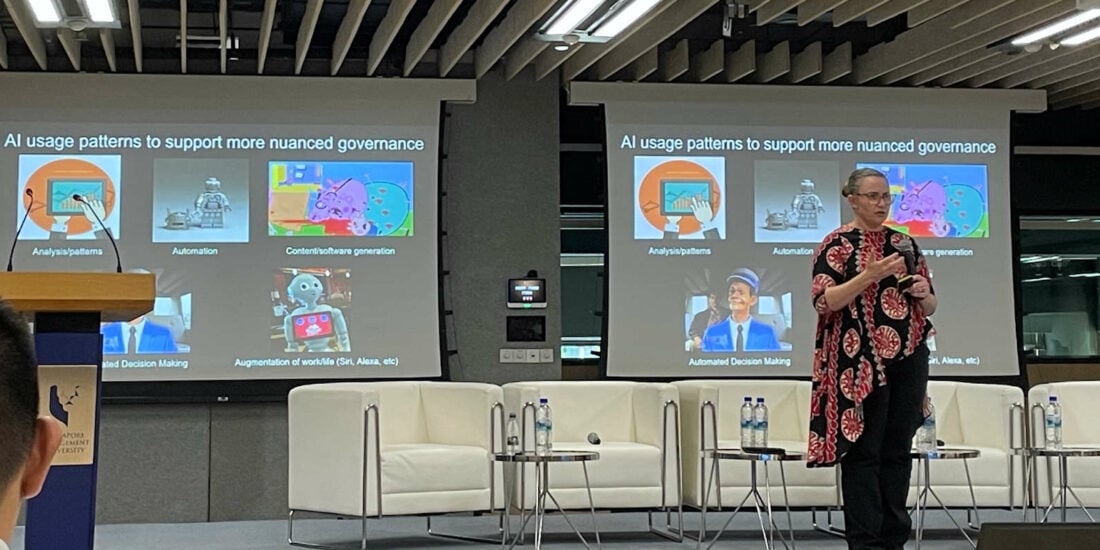
Lawyer + Machine = ?
Introduction – The Cyborg Lawyer
Man-machine hybrids such as cyborgs have long been a staple of science fiction stories and movies. Typically, fictional cyborgs emanate both foreboding (think Darth Vader of Star Wars) and invincibility (think the Borg of Star Trek – “resistance is futile”). While humanity is still a long way from bringing cyborgs into reality, the increasing interactions between man and machine will inevitably create more opportunities for man-machine collaboration. In July 2017, an Australian lawyer commented that the future of the profession will be won by “cyborg lawyers” who “leverage technology, making them smarter, faster and more effective”.1 Emma Ryan, “‘Cyborg lawyers’ the future of the profession, says CEO” Lawyers Weekly (12 July 2017) <https://www.lawyersweekly.com.au/biglaw/21464-cyborg-lawyers-the-future-of-the-profession-says-ceo> (accessed 25 October 2018).
This article examines two recent ideas in man-machine collaboration – transformation of business processes and digital doubles – which may impact the legal profession in the future. These ideas are primarily driven by machine learning, a concept which is briefly covered in the next section.
Machine Learning
Machine learning is “the field of study that develops the algorithms that the computers follow in order to identify and extract patterns from data”.2 John D. Kelleher and Brendan Tierney, Data Science (Cambridge, Massachusetts: The MIT Press, 2018), at p 97 (“Data Science”). Most machine learning algorithms are categorised as either supervised learning or unsupervised learning.3Data Science, id, at p 99. (For more information, see our September 2018 article titled “What is Your Artificial Intelligence Quotient?”.)
While lawyers do not generally need to know machine learning in depth, lawyers should understand that machine learning differs from computer programming. Put simply, programming requires giving a computer detailed instructions to a computer to execute a certain function, whereas machine learning entails the computer writing its own program based on data given to it.4 See Pedro Domingos, The Master Algorithm: How the Quest for the Ultimate Learning Machine Will Remake Our World (New York: Basic Books, 2015), at p 7 (“The Master Algorithm”). This means that the quality of machine learning will depend greatly on both the quantity and quality of the data available. The rise of big data has therefore accelerated the growth of machine learning.5The Master Algorithm, id.
Transformation of Business Processes
Through machine learning, some AI futurists are optimistic that humans will be freed from performing routine, repetitive and time-consuming tasks so that they can focus on issues requiring judgment and dispute resolution.6 Paul R. Daugherty & H. James Wilson, Human + Machine: Reimagining Work in the Age of AI (Boston, Massachusetts: Harvard Business Review Press, 2018), at p 5 (“Human + Machine”). Called “the third wave of business transformation”, the man-machine combination seeks to achieve the best of both worlds with machines “augmenting human capabilities” and humans complementing machines.7Human + Machine, id, at p 8.
Instead of a man vs machine mindset, the new AI wave will require businesses to reimagine their business processes to see how to adapt them to meet real-time needs.8Human + Machine, supra n 6, at p 6. New jobs may also be created to oversee and monitor machine learning systems used by businesses.9Human + Machine, supra n 6, at pp 11, 131-2.
There are signs that legal artificial intelligence (legal AI) is moving in this direction. For example, a San Francisco-based full-service corporate law firm called Atrium is looking at using machine learning software to perform routine corporate legal work for startups, so that startups can direct legal expenditure towards higher-value legal advice instead.10 Gene Marks, “Are robots coming for your lawyer?” The Guardian (13 September 2018) <https://www.theguardian.com/business/2018/sep/13/ai-firm-atrium-legal-law-attorneys>
(accessed 25 October 2018).
Digital Doubles
Another futuristic idea arising from machine learning’s growth is that humans will have “digital doubles” who will be proxies to make decisions in “virtual interactions” such as buying a car online.11 Pedro Domingos, “Our Digital Doubles” Scientific American (September 2018), at p 85 (“Our Digital Doubles”). The digital double can make informed decisions based on data learned from our online transactions and will make better and more accurate decisions as it receives more data.12 “Our Digital Doubles”, id, at pp 84-5.
Can digital doubles work for the legal profession in the future? It may well be that as more and more interactions with other parties take place online, a platform may be developed whereby lawyers can delegate the handling of routine tasks with these third parties to their digital doubles, thus saving time and costs. Naturally, ethical, privacy and security issues will need to be considered, but in principle using digital doubles may only be a more sophisticated extension of current AI automated customer interaction systems such as Amazon’s Alexa.13 “Our Digital Doubles”, supra n 11, at pp 84; see also Human + Machine, supra n 6, at p 86. Indeed, it may not be too far-fetched to imagine a not-too-distant future where a client’s chatbot communicates with a law firm’s chatbot to fix a meeting’s date and time without any human intervention.
Conclusion
As the title of this article suggests, the outcomes of lawyer-machine collaborations have yet to be determined. While much will depend on the progress of machine learning algorithms and the availability and quality of data, another important factor will be lawyers’ ability to reimagine their business processes and online interactions to leverage on suitable legal AI technologies when they are developed. Cyborg lawyers may not be that far away.
Endnotes
| ↑1 | Emma Ryan, “‘Cyborg lawyers’ the future of the profession, says CEO” Lawyers Weekly (12 July 2017) <https://www.lawyersweekly.com.au/biglaw/21464-cyborg-lawyers-the-future-of-the-profession-says-ceo> (accessed 25 October 2018). |
|---|---|
| ↑2 | John D. Kelleher and Brendan Tierney, Data Science (Cambridge, Massachusetts: The MIT Press, 2018), at p 97 (“Data Science”). |
| ↑3 | Data Science, id, at p 99. |
| ↑4 | See Pedro Domingos, The Master Algorithm: How the Quest for the Ultimate Learning Machine Will Remake Our World (New York: Basic Books, 2015), at p 7 (“The Master Algorithm”). |
| ↑5 | The Master Algorithm, id. |
| ↑6 | Paul R. Daugherty & H. James Wilson, Human + Machine: Reimagining Work in the Age of AI (Boston, Massachusetts: Harvard Business Review Press, 2018), at p 5 (“Human + Machine”). |
| ↑7 | Human + Machine, id, at p 8. |
| ↑8 | Human + Machine, supra n 6, at p 6. |
| ↑9 | Human + Machine, supra n 6, at pp 11, 131-2. |
| ↑10 | Gene Marks, “Are robots coming for your lawyer?” The Guardian (13 September 2018) <https://www.theguardian.com/business/2018/sep/13/ai-firm-atrium-legal-law-attorneys> (accessed 25 October 2018). |
| ↑11 | Pedro Domingos, “Our Digital Doubles” Scientific American (September 2018), at p 85 (“Our Digital Doubles”). |
| ↑12 | “Our Digital Doubles”, id, at pp 84-5. |
| ↑13 | “Our Digital Doubles”, supra n 11, at pp 84; see also Human + Machine, supra n 6, at p 86. |






